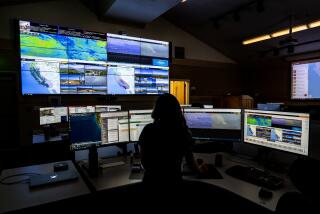Proposals for Aircraft Plummet Further From Orbit : Technology: Budget cuts again reduce scope of the National Aero-Space Plane project, based in Palmdale. Some scheduled tests will be eliminated.
- Share via
PALMDALE — Hit by a new round of deep federal budget cuts, designers of the National Aero-Space Plane are planning further slowdowns in testing of the futuristic craft, originally intended to vault from a runway into Earth orbit at speeds up to Mach 25.
Congress last week slashed the fiscal-year budget for the Palmdale-based project to $60 million, down from $150 million the previous year and $258 million in 1990. The steady erosion of congressional support in recent years has forced continual scaling back of the hypersonic aircraft, long considered a potential showcase of advanced technology.
The aircraft initially was designed to take off from a runway, like an ordinary plane and to be boosted into Earth orbit by rockets at speeds of up to Mach 25--more than 17,000 m.p.h. Backers said it would provide cheaper access to space than the space shuttle and maintain American leadership in cutting-edge space technology.
Over the past several years, however, budget cuts have forced program managers to drastically trim their goals, abandoning the idea of reaching orbit. In December, the Air Force said the craft’s speed would be reduced to Mach 15, too slow to punch into space. The world’s fastest operational aircraft is the SR-71 Blackbird, a NASA research plane that flies at more than Mach 3.
In addition, the space plane may not take off on its own, but would be launched from the back of another aircraft, as have previous generations of experimental aircraft. Designers say even with assisted takeoff, they could still study hypersonic flight--meaning at six times the speed of sound or more--but at less expense.
As budget cuts have deepened in recent years, designers have shifted from building a flyable prototype to developing the space plane’s air-breathing scramjet engine, ultra-high heat-resistant skin and other exotic components.
The project’s overall budget has been cut by two-thirds, to between $2.5 billion and $3.5 billion. Taxpayers have spent about $1.8 billion on it so far.
The Clinton Administration had asked Congress to approve more than $123 million for the plane this fiscal year, and California lawmakers lobbied for it, arguing that it would generate high-quality jobs and promote “dual-use” technology, with both military and civilian applications.
Congress was not to be swayed, however. At one point in the budget process, the project was targeted for closure and all funds for it were cut. But supporters managed to insert $60 million in bills to fund the National Aeronautics and Space Administration and the Defense Department.
Space plane designers said the latest cuts will force them to abandon at least some scheduled tests but that other work will proceed.
Tom Harsha, deputy director of the program, said engineers probably will not have the several million dollars needed to build a super-high-speed wind tunnel in Buffalo, N.Y., which was to have exposed plane models to air speeds up to Mach 12.
Harsha said the goal now is to move forward with as much materials development as possible while holding the project’s engineering team together. He predicted that Congress eventually will reverse itself and provide more money for the plane.
At its peak, the space plane program had 3,000 workers. Today, it employs only about 500 at plants around the United States. About 45 to 65 work at the project’s national headquarters in Palmdale.
The space plane is being designed by a unique consortium of four major defense and aerospace contractors: Canoga Park-based Rocketdyne, Lockheed Corp., McDonnell Douglas, and Pratt & Whitney.
Rocketdyne, the San Fernando Valley’s biggest aerospace employer, received about $18 million from the space plane program last fiscal year. About 90 to 100 Rocketdyne employees are assigned to the project.
A company spokesman said he did not know how many, if any, workers might have to be laid off as a result of the most recent federal cuts.
Rocketdyne said last week that it will eliminate up to 990 jobs over the next year due to overall cuts in NASA’s budget. The firm also makes engines for the space shuttle and is developing the electrical power system for the space station.
More to Read
Inside the business of entertainment
The Wide Shot brings you news, analysis and insights on everything from streaming wars to production — and what it all means for the future.
You may occasionally receive promotional content from the Los Angeles Times.










